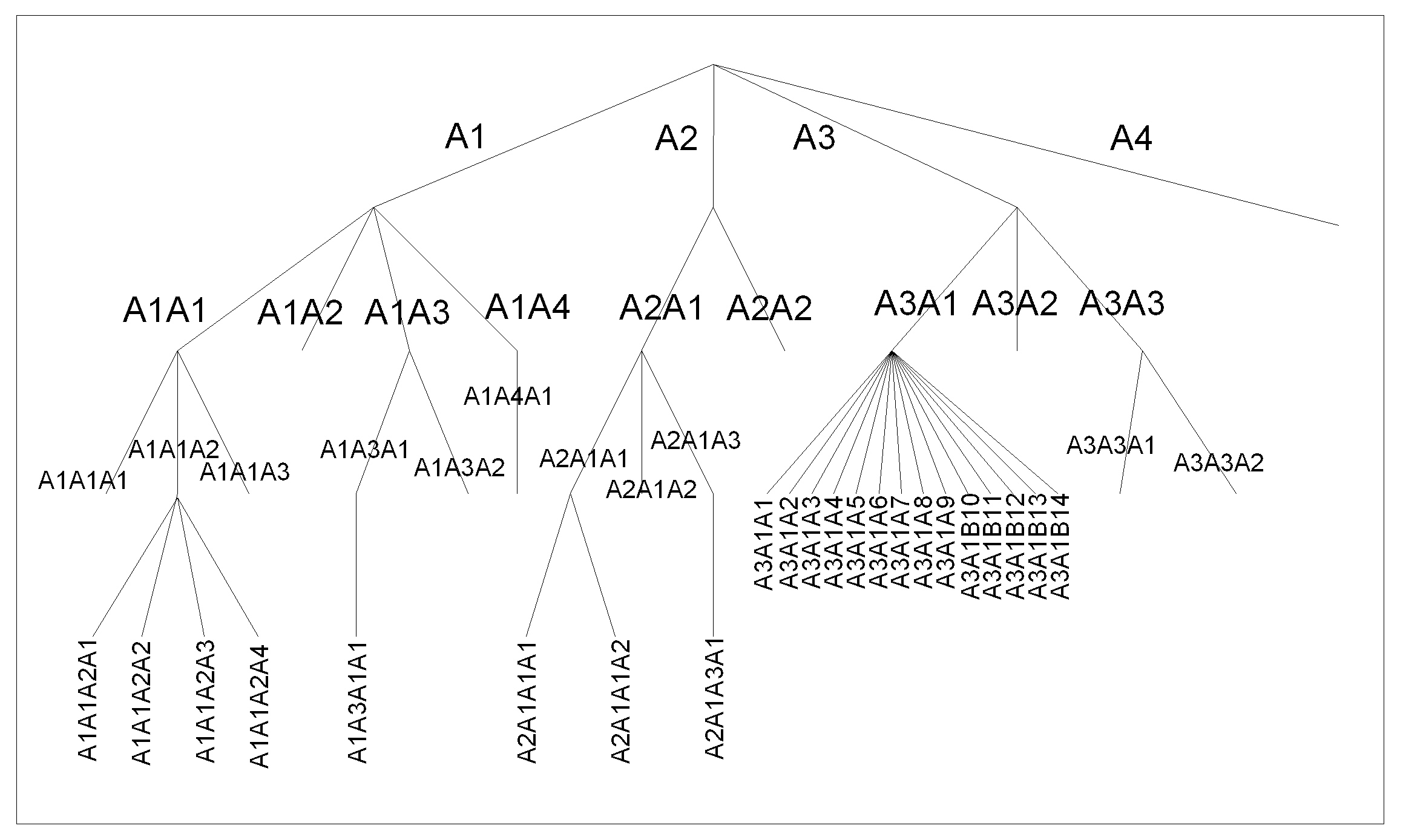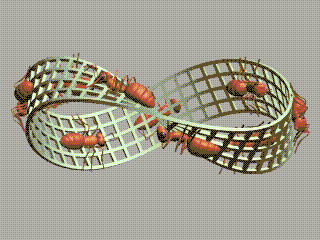Comment citer ce document ?
Jacques-Deric
Rouault, 2012. The monoalpha-multinumeric numeration : a numeration
compatible with the lexicographic order and concatenation. Rastell Toull page C115.
The
monoalpha-multidecimal
numeration consists in gathering a first number made up with a sole
Latin alphabetic numeral A-Z and a second classical decimal number
expressed with Arabic numerals 0-9. The alphabetic numeral codes the
number of decimal figures of the second number (A=1, B=2, …, Z=26).
This process provides a total compatibility between the decimal
writing and the alphanumeric sort, assuring a maximal compactness and
integrating a redundancy check. This numeral system is wholly
compatible with the lexicographic order used in computers. These
monoalpha-multidecimal numbers can be directly concatened and the
result is also compatible with the lexicographic order. This numeral
system provides an economic way of naming all the branches of a tree.
When a name of file or of
directory is coded by a number, the alphanumeric sort used in
computer operating systems imperfectly restores the natural numeric
order of numbers. For instance, the alphanumeric sort of the numbers
1, 2, 3, 4, 10, 11, 12, 20, 23, 105 provides the order 1, 10, 105,
11, 12, 2, 20, 23, 3, 4 instead of the natural numeric order. We are
looking for a numeral system of integer numbers close to the
classical decimal numeration and compatible with the lexicographic
order.
A first solution consists in
prefixing the decimal number by zeros, thus assigning all numbers to
present the same number of figures. The compatibility with the
alphanumeric sort is then acquired. However, the value of the
greatest codable integer has to be firstly fixed , and usually this
value is unknown when initiating the process.
Two drawbacks are then possible:
in the first one, the greatest codable integer is overestimated and a
lot of useless zeros are trailed, weighting down the writing and
significantly reducing the readability. In the second one, the
greatest codable integer is underestimated and the current numeration
has to be remelted by adding an extra zero at the beginning of all
the names of files or directories previously created. This revision
does not set a particular technical problem, but its cost may be
prohibitive, as for the Y2K bug where the year was coded by the two
last figures instead of the four ones, making the year 1999 followed
by 1900. The "...97, 98, 99, 00..." ascending numbering assumption suddenly became invalid.
In the second solution advanced
here, we propose to prefix the decimal number by a first figure which
codes the number of figures composing the decimal number. To make the
reading easier and to limit confusions, the first figure is taken in
the Latin alphabet with the convention A=1, B=2, C=3, ..., Z=26. This
figure can indifferently be written in capitals or lower-case
letters, but to avoid any problems with operating systems making the
differences between upper and lower case letters (such as UNIX), the
use of capitals is strongly recommended.
This monoalpha-multidecimal numeration is written as
follows : A0, A1, A2, ..., A9, B10, B11, ..., B99, C100, C101, ...,
C999, D1000, D1001, etc ...
The compatibility with the
alphanumeric sort is complete (property false for the decimal numeration) and the compactness is optimal because
only a single figure is added to the classical decimal writing.
The
greatest expressible value in this numeration is 1026-1,
usually convenient for all common applications.
There
already exist several alphadecimal numerations: the hexadecimal or
base-16 numeration based on the 10 Arabic decimals 0-9 and the first
6 capital Latin letters A-F, the hexatridecimal, sexatrigesimal or
hexatrigesimal numeration or base-36 based on the 10 Arabic numerals
0-9 and the 26 Latin letters A-Z, or other numerations in base-64. In
the numeration proposed here, differently from the above alphadecimal
numerations, the Latin letters and the Arabic decimals are located at
definite places of the number. This is why, to avoid any ambiguity, we qualify it
as monoalpha-multidecimal
numeration in order to specify that it is based upon a first Latin
letter followed by one or several Arabic decimals.
Coding numbers by letters was
relatively common in the antiquity, in particular in the Hebraic and
Greek civilizations (Ifrah, 1981).
However in these alphabets, if the 9 first
letters code the units, the 10 following ones codes tens and the last
letters the first hundreds. It however exists an archaic system of
numeration
based on the 24 Greek letters, dated form the VI century
BC, and analogous to the one desrcibed here. This system, which does
not exceed 24, was in
particular used to number the 24 books of Iliad and Odyssey (Reinach, 1885).
The
kind of code we propose here can also be compared to the code of
variable length strings in some computer languages. In the string of
characters, each character is coded by one byte (value in 0..255),
and there is an extra first byte coding the actual number of bytes present
in the string. In other languages, the string is completed by a byte
with a predefined value (usually ASCII 3) which marks the end of the
string, in the same manner as a stop
codon in a DNA sequence.
The complete structuration of the
monoalpha-multidecimal numeration can also be interpreted as
integrating a redundancy check, as even bits (Spataru 1987). thus warranting the
integrity when transferring or storing data. All possible sequences
are not valid, for instance the numbers 1B2 and B123 are obviously
wrong and show a corruptness of data.
In order to increase the
readability of large integer numbers, a separator symbol (blank,
point in French language, comma in English language) is usually added
every 3 decimals. This use remains compatible with the
monoalpha-multidecimal numeration, under the constraint it is applied
to all numbers of the serial. Because of reasons of compatibility
with the different operating systems of computers, the choice of the
underscore character (ASCII 95) used for writing numbers in the ADA
language (Taft & Duff, 1997) is highly recommended.
In
order to code numbers with more than 26 figures, the length will be
coded with two alphabetic Latin characters, allowing numbers up to
1026*26=10676.
Then, we call it the dialpha-multidecimal numeration. And so on …
This method of prefixing with a
Latin figure can also be extended to binary, hexadecimal, …,
numerations.
The
direct concatenation of two or several integers can be read as a single
integer or as several integers written in a fixed format. For
instance le number 20080611 can also be considered as the eleventh
day of the sixth month of 2008 in the fixed format YYYYMMDD. In order
to remove any ambiguity, the writing D2008A6B11 clearly shows that
this number is a concatenation of three integers. Because in the
ASCII table integers (codes 48-57) are ranked before upper-case
letters (65-90) and lower-case letters (97-122), the concatenation of
monoalpha-multidecimal numbers is wholly compatible with the
lexicographic order. A1B12 is before B12A1 because A is before B, A1C124 is before A1D1308 because C is before D.
Nommer les branches d'un arbre
|
In
a tree, the name of a branch is the concatenation or the name of the
previous branch and of the rank of the branch at the node. The use of
the monoalpha-multidecimal numeration provides a natural way to name
all the branches in an order compatible with the lexicographic order
(Figure 1)

Figure
1 : Naming the branches of a tree by concatening
monoalpha-multidecimal numbers
In
the tree of figure 1, the names of the 46 branches are automatically
ranked in the lexicographic order A1, A1A1, A1A1A1, A1A1A2, A1A1A2A1,
A1A1A2A2, A1A1A2A3, A1A1A2A4, A1A1A3, A1A2, A1A3, A1A3A1, A1A3A1A1,
A1A3A2, A1A4, A1A4A1, A2, A2A1, A2A1A1, A2A1A1A1, A2A1A1A2, A2A1A2,
A2A1A3, A2A1A3A1, A2A2, A3, A3A1, A3A1A1, A3A1A2, A3A1A3, A3A1A4,
A3A1A5, A3A1A6, A3A1A7, A3A1A8, A3A1A9, A3A1B10, A3A1B11, A3A1B12,
A3A1B13, A3A1B14, A3A2, A3A3, A3A3A1, A3A3A2, A4. The lexicographic
order describes the tree by taking first at each node the rightest
branch. Even for a branch at the fourth level, the name (for instance
A2A1A3A1) remains easily readable.
The
monoalpha-multidecimal numeration was previously developed in the
particular context of building up a data base devoted to an
exhaustive census of transposable elements. They are short DNA
sequences more or less highly repeated in the genomes of living
organisms. A same transposable element can be found in different
organisms, and will therefore be identified under different names in
the available data banks. From the fact that two transposable
elements presenting different lengths will be necessarily different,
the transposable elements are then coded following their number of
pairs of bases using the monoalpha-multidecimal numeration. The name
of a sequence is built as the concatenation of the two numbers coding
their length and their order of appearance, for instance C451B48.
Comparing a new element to those previously recorded is then strongly
accelerated following a process of quick sort, because one need only
to compare it with those of the same length, which names becomes with
the same first number.
Ifrah G, 1981-1994. L'alphabet et la numération. pp
511-545. In Histoire universelle des chiffres. Volume 1. Bouquins.
Robert Laffont. 1042 pp
Ifrah G, 1998. The universal history of numbers. From prehistory to the invention of the coimputer, Wiley.
Reinach S. 1885. Traité
d'épigraphie grecque. E Leroux, Paris. 2000 Reproduction en
fac-similé.
Spataru A, 1987. Fondements de la théorie de l'information.
Presses polytechniques Romandes. 644 pp.
Taft T, Duff RA, 1997. ADA 95 Reference
Manual. Language and standard libraries: International standard
ISO/IEC 8652:1995(E). Lecture notes in computer sciences n°1246.
Springer Verlag. 526 pp.
Year 2000 bug
http://fr.wikipedia.org/wiki/Passage_informatique_%C3%A0_l%27an_2000
http://en.wikipedia.org/wiki/Year_2000_problem
Numeration
http://fr.wikipedia.org/wiki/Num%C3%A9ration
http://fr.wikipedia.org/wiki/Syst%C3%A8me_de_num%C3%A9ration
http://fr.wikipedia.org/wiki/Les_Shadoks#Arithm.C3.A9tique_-_compter_en_Shadok
http://en.wikipedia.org/wiki/Numeral_system
Autolien
Cette page utilise les articles
Articles utilisant cette page
Articles connexes
This page 115 is the English version of page C104.

